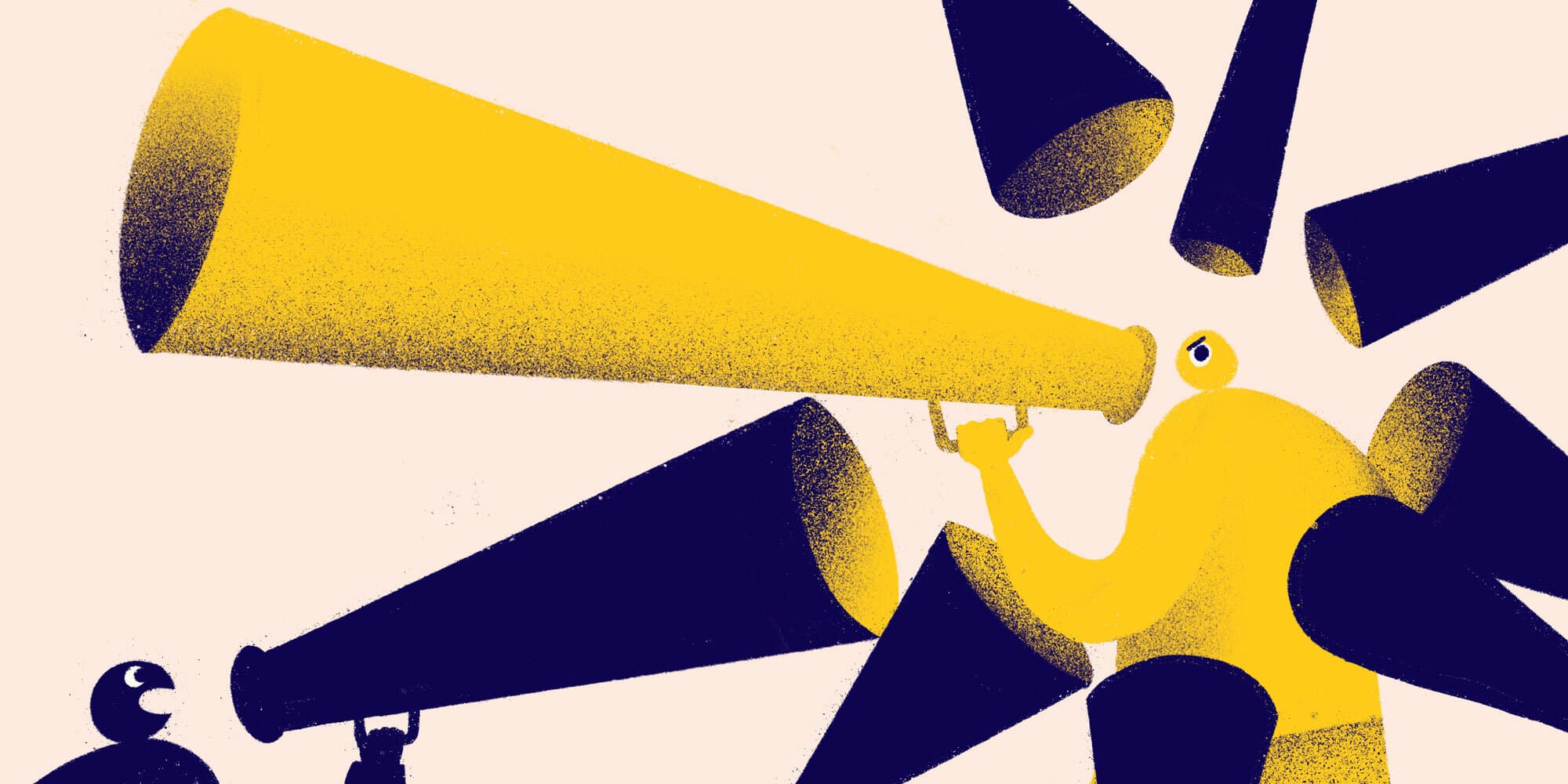Why RFPs Aren’t Good for Anyone
Making the case for a better approach to selecting agency partners.
By Sruthi Sadhujan, Senior Strategy Director and Deroy Peraza, Partner at Hyperakt
There may be some comfort in putting together a Request for Proposal and sending it out to a selection of design firms. In theory, it makes sense: You spell out exactly what you need and when you need it and the agencies attempt to convince you they would be your ideal partner. You get to compare proposals, see how pricing differs, possibly even get some initial ideas for solving the problem you’ve outlined. No-brainer, right? Well, not really.

Illustration by Merit Myers
The RFP process has a number of faults — the biggest one being that it doesn’t initiate a great partnership or yield exceptional work.
The Problem(s) with the RFP
Because it’s formulaic and standardized, the RFP seems like it levels the playing field, makes everything easy on you and your team, and unearths all the information you’ll need to make an objective decision. In fact, the opposite is true.
Most RFPs we encounter from nonprofits outline a specific problem the organization wants to solve. But defining the problem in itself requires expertise and an outside perspective — exactly what you’re looking for in a partner. And in our experience, the problem you’re hiring someone to solve is often not the real problem at all.
Second, a great solution — the visual artifact you put out in the world — is only as good as the process that leads to it. That process is all about people interacting, collaborating, listening to each other, and being guided to enable such an artifact to be possible. So it’s critical that the right chemistry is there for great work to happen. No matter how thorough the RFP process is, it will never give you a full, honest, authentic picture of the team you are about to task with a very important project. In fact, the process tends to homogenize respondents, as each agency shares the same kinds of work samples, ill-informed guesses at possible strategies, and ballpark fees based on fuzzy scopes of work. And because the information flow is one-directional — from the agencies to you — it leaves out critical information about the culture of your own team that’s essential to determine if you and any given firm are a great match.
Finally, while your charter or Board of Directors may require that you solicit bids from three or more agencies for projects like this, let’s acknowledge that the RFP process is a big waste of time for your organization and for the agencies pitching for your business. Most of the design firms on your list are small companies whose resources are taxed by all the work required to submit a proposal. (If you’ve already made up your mind and the other firms don’t have a shot, then the process is really unfair.) And consider the amount of time your organization invests in creating, sending out, and assessing RFPs and then hashing out the final selection.
Can you learn the same information in less time? Can you learn the same info in a better way? Can you learn better info in a better way?
A Better Way to Choose a Strategic Partner
Instead of the time-wasting, fuzzy RFP slog, there’s a different way — a way that will yield fresh, effective, co-created ideas and will make the process a hell of a lot more exciting for everyone involved.
1) Orient the process towards conversation rather than documents.
Start by creating a thorough project brief you can share with prospective partners. This can serve as a conversation starter when you talk to potential agency partners about your organization, your project, and what’s keeping you up at night. It will help you organize your thoughts, and help potential creative partners ask better questions. Trust your instincts; you'll know if the chemistry is right when you talk to someone. You'll know when there’s enough common interest to want to jump into a working relationship.
If an agency’s experience, expertise, and interest in being your partner isn’t obvious to you after you talk to them, or if they’re not exactly what you’re looking for, it’s better for both parties to be honest about it early on rather than go through the cumbersome and forced process of lengthy courtships and proposals. No hurt feelings.
Worried about verifying credentials? Agency websites showcasing past projects, personal referrals, or past client testimonials allow you to do that.
Worried about prices? If you’re comparing analogous firms (similar size and market), pricing is going to be about the same give or take 10% to 15%. If you’re comparing vastly different firms (very small vs. huge or firms with different expertise), you’ll obviously get very different responses. This approach is usually indicative of the fact that you haven’t properly defined your project or your team lacks understanding of the agency landscape. Both of these will put you in a bad position to choose the right partner, which is yet another reason why it’s better to rely on exploratory conversations rather than formal proposals.
2) Start with Discovery instead of diving into the full project.
If you’re going through the trouble and time of putting together an RFP, you are probably ready to invest a substantial amount of money on your project. If you’re about to spend $100K to $300K on a project, it’s understandable that you want to be confident in choosing the right partner, but an agency’s RFP response, much like an individual’s college GPA, will only tell you so much.
There’s no better litmus test than working with the agency partner your instinct is pointing you toward, but you can start small. Rather than engaging in the full project scope, ask if you can contract them for a narrower Discovery scope. The objective of this engagement is to conduct all the necessary research (landscape, audience, creative, etc.) to properly define your project’s objectives and opportunities. This is work that will need to get done anyway. Doing it as an initial engagement grants you the double benefit of letting you test out the working relationship and setting you up to invest in the project you really need rather than the one you thought you needed. At 10% to 20% of the overall project budget, you’re effectively removing most of the risk of investing your full budget in the wrong project with the wrong partner.
Relationships Don’t Start on Paper
Just as you wouldn’t choose a life partner solely based on their qualifications on paper, you shouldn’t choose a creative partner that way. And we mean partner — this is a significant relationship. Our clients talk about working with us as therapeutic. They tell us about what they are struggling to achieve, the pressures they are facing from the board or from competition, a constant race to keep up with technology standards, a lack of alignment among staff about purpose and values. Almost always, they hit a point where they have to wrestle with deeply existential questions of who they are and how they fit into this world.
The RFP process is far too impersonal, abstract, and clinical to yield a deep relationship with an agency that’s passionate about and committed to advancing your cause. The organizations that sidestep the RFP process and choose to work with us are ready to have a different conversation. They demonstrate they’re excited about finding a way to work together and inherently trust in our expertise. This public display of affection immediately makes us feel more committed and excited about finding a way to work together.
In the end, it leads to deeper relationships, more immediate trust — and more effective work.
What do you think?
Do you think that RFPs are a necessary evil? Or have you been similarly frustrated by gazillions of hours that go into writing the RFP and reviewing all of the responses?
Tell us what you think. If you’re open to doing things a new way, then let’s talk.


